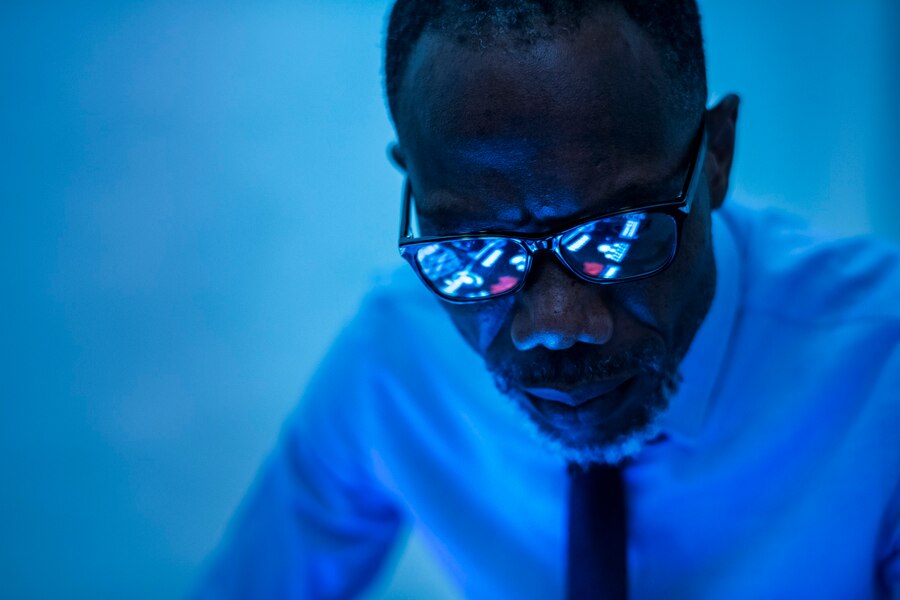As digital technology has taken over, displays have a bigger and bigger role in our daily life. We are surrounded by artificial light sources all the time, especially blue light, whether we are using a computer, binge-watching our favourite shows, or browsing social media on our phones. The growing trend of blue light glasses can be attributed to worries about the possible harm that extended exposure to blue light may cause. However, what do these glasses actually do, and are they really worth the hype? The science of blue light, the alleged advantages of blue light glasses, and the most recent studies on their efficacy will all be covered in this article.
Understanding Blue Light
To comprehend the role of blue light glasses, it’s essential to understand what blue light is and its sources. Blue light is a type of high-energy visible (HEV) light that has a shorter wavelength and higher energy compared to other colors in the visible light spectrum. It is naturally present in sunlight and is crucial for regulating our circadian rhythm and maintaining a healthy sleep-wake cycle.
However, the increasing use of digital devices such as smartphones, computers, and LED lighting has exposed us to higher levels of artificial blue light. Prolonged exposure, especially during the evening, has been linked to disruptions in sleep patterns, eye strain, and potential long-term effects on eye health.
The Impact of Blue Light on Sleep
One of the primary concerns associated with blue light exposure is its impact on sleep quality. The human body has an internal clock known as the circadian rhythm, which regulates the sleep-wake cycle. Exposure to natural light, particularly in the morning, helps synchronize this internal clock. However, artificial sources of blue light, especially in the evening, can interfere with the production of melatonin, a hormone that regulates sleep.
Research suggests that exposure to blue light in the evening can suppress melatonin production, leading to difficulty falling asleep and disrupted sleep patterns. Blue-light glasses aim to address this issue by reducing the amount of blue light reaching the eyes, particularly during the evening hours.
How Blue Light Glasses Work
Blue light glasses, also known as blue light blocking or filtering glasses, are designed to reduce the amount of blue light that reaches the eyes. These glasses typically have special coatings on the lenses that absorb or block a portion of the blue light emitted by digital screens and artificial lighting.
The lenses in blue light glasses are often yellow or amber tinted, as these colors are effective in filtering out blue light. The tint works by absorbing the shorter wavelength blue light, allowing only a reduced amount to reach the eyes. Some blue light glasses also incorporate anti-reflective coatings to minimize glare and enhance visual comfort during screen use.
Benefits of Blue Light Glasses
- Improved Sleep Quality: The primary touted benefit of blue light glasses is their potential to improve sleep quality. By reducing the exposure to blue light during the evening, these glasses aim to minimize the disruption of the circadian rhythm and promote the natural production of melatonin, thereby enhancing the quality of sleep.
- Reduced Eye Strain and Fatigue: Prolonged screen time often leads to digital eye strain, characterized by symptoms such as dry eyes, blurred vision, and headaches. Blue light glasses claim to alleviate these symptoms by minimizing the impact of blue light on the eyes, reducing eye strain, and providing a more comfortable viewing experience.
- Prevention of Potential Eye Damage: While the long-term effects of blue light exposure on eye health are still under investigation, some studies suggest a potential link between excessive exposure to high-energy visible light and retinal damage. Blue light glasses, by reducing the amount of blue light entering the eyes, claim to offer a preventive measure against potential eye damage.
- Enhanced Productivity and Performance: Users of blue light glasses often report improved focus and concentration during extended periods of screen use. By minimizing the negative effects of blue light, these glasses aim to enhance overall productivity and performance, especially in work or study settings.

Current Research and Controversies
Despite the growing popularity of blue light glasses, the scientific community remains divided on their efficacy and the extent of the impact of blue light on health. Some studies support the idea that reducing blue light exposure in the evening can positively influence sleep quality and reduce eye strain. However, other research suggests that the effects of blue light on sleep might be more complex and influenced by individual differences.
A 2018 study published in the journal Ophthalmic and Physiological Optics found that wearing blue light-blocking glasses in the evening had a significant positive impact on sleep quality and mood in individuals who reported prolonged screen time before bedtime. However, the study also noted that the effects varied among participants, and more research is needed to determine the long-term benefits.
READ MORE: How To Remove Scratches From Glasses
On the other hand, a 2020 review published in the journal Sleep Medicine Reviews questioned the overall impact of blue light-blocking glasses on sleep, emphasizing the need for more robust and consistent evidence. The review suggested that factors such as the intensity and timing of light exposure, individual differences, and the types of screens used could influence the outcomes.
It’s important to note that the American Academy of Ophthalmology acknowledges the potential discomfort associated with prolonged screen use but emphasizes that more research is needed to determine the long-term effects of blue light on eye health.
Practical Considerations and Alternatives
While blue light glasses may offer some benefits, they are not a one-size-fits-all solution. Individuals with specific concerns about sleep quality or eye strain should consider adopting a holistic approach to reduce digital eye strain and promote better sleep hygiene:
- Follow the 20-20-20 Rule: To reduce eye strain, follow the 20-20-20 rule. Every 20 minutes, take a 20-second break, and look at something 20 feet away. This helps relax the eye muscles and reduce fatigue.
- Adjust Screen Settings: Most digital devices allow users to adjust screen brightness, color temperature, and font size. Lowering screen brightness and using warmer color temperatures during the evening may help minimize the impact of blue light.
- Use Night Mode: Many devices and applications offer a night mode or blue light filter option. Enabling this feature during the evening hours can reduce the amount of blue light emitted by screens.
- Limit Screen Time Before Bed: To promote better sleep, limit screen time at least an hour before bedtime. Engage in relaxing activities, such as reading a book or practicing mindfulness, to signal to the body that it’s time to wind down.
Conclusion
In conclusion, blue light glasses aim to address the potential negative effects of prolonged exposure to artificial blue light, particularly in the evening. While some studies suggest positive outcomes in terms of improved sleep quality and reduced eye strain, the scientific community remains cautious, calling for more robust research to establish the long-term benefits and potential drawbacks of these glasses.
Individuals concerned about the impact of blue light on their health should consider adopting a comprehensive approach, including adjusting screen settings, following the 20-20-20 rule, and limiting screen time before bedtime. While blue light glasses may offer some relief, they are not a substitute for healthy screen habits and overall well-being. As research in this field continues to evolve, it is essential to stay informed about the latest findings and recommendations for maintaining optimal eye health in the digital age.

